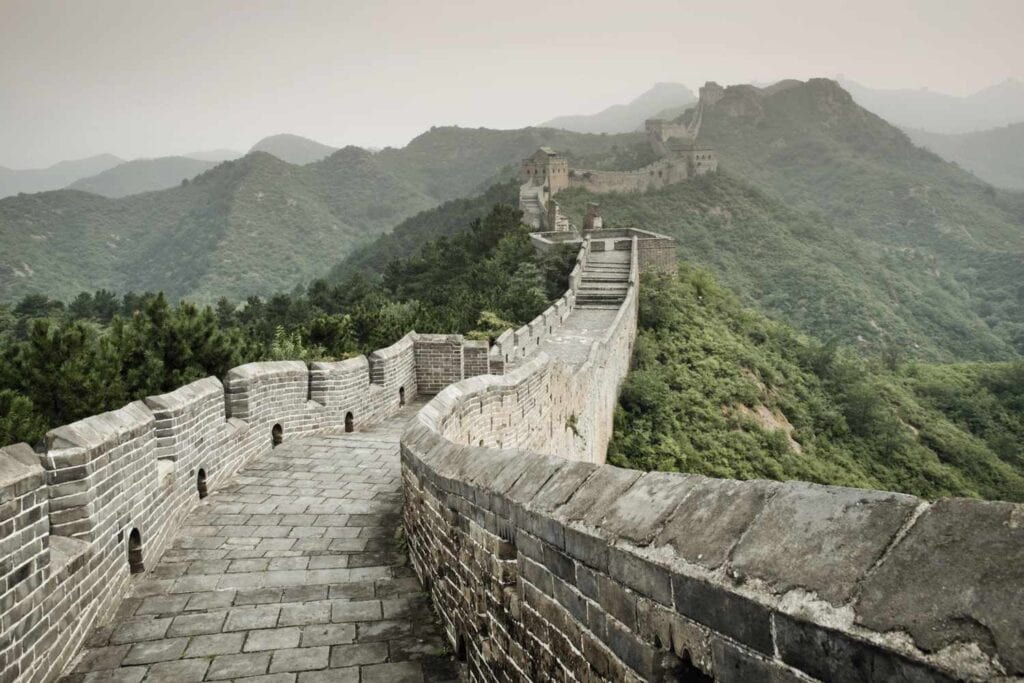The Great Wall of China is a breathtaking and awe-inspiring feat of human engineering and construction. Stretching over 13,000 miles across northern China, it winds its way through mountains, valleys, and deserts, a testament to the ingenuity and determination of the Chinese people.
| Address | Huairou District, China, 101406 |
| Hours | Open ⋅ Closes 4:30PM |
| Phone | +86 10 6162 6022 |
| Length | 13,171 mi |
| Opened | 220 BC |
| Size | 21,196.18 km (13,170.70 mi) |
| Diameter | 13,171 mi |
| UNESCO Site Id | 438 |
Construction on the Great Wall began over 2,000 years ago, and it has been continually expanded and renovated over the centuries. It served as a defensive barrier against invaders from the north and as a means of controlling trade and communication between different regions of the country.
Today, the Great Wall is one of China’s most famous landmarks and a UNESCO World Heritage Site. It attracts millions of visitors each year, who come to marvel at its grandeur and to walk along its ancient ramparts.
Whether viewed from a distance or experienced up close, the Great Wall of China is a testament to the human spirit and a reminder of the enduring power of human civilization. It is a must-see destination for anyone traveling to China.
Here are 40 fun facts about the Great Wall of China.
- The Great Wall of China is the longest wall in the world, stretching over 13,000 miles.
- It was built over a period of more than 2,000 years, from the 7th century BC to the 17th century AD.
- The Great Wall was built primarily for defense purposes, to protect China from invasions by foreign armies.
- The wall was constructed using a variety of materials, including brick, tamped earth, and stone.
- The Great Wall is not a continuous structure, but rather a series of fortifications that were built and maintained by different dynasties throughout China’s history.
- The Great Wall is not visible from space with the naked eye, contrary to popular belief. However, it can be seen from space with the help of a camera or other high-resolution imaging equipment.
- The Great Wall was declared a World Heritage Site by UNESCO in 1987.
- The Great Wall is not straight, but rather follows the contours of the land, snaking over mountains and valleys.
- The Great Wall was not just a wall, but also included a network of military garrisons, watchtowers, and beacon towers.
- There were many sections of the Great Wall that were never completed, due to a variety of reasons including financial constraints, political instability, and natural disasters.
- The Great Wall was not always successful in preventing invasions, as various foreign powers were able to breach the wall and conquer China throughout its history.
- The Great Wall was not always a popular project among the Chinese people, as it required a large amount of labor and resources to construct and maintain.
- The Great Wall is not just one wall, but rather a series of walls that were built at different times and in different parts of the country.
- The Great Wall was not always visible on the ground, as many sections have been destroyed or dismantled over the centuries.
- The Great Wall is not just a single structure, but also includes a network of fortifications and military installations that were built along its length.
- The Great Wall was not just used for military purposes, but also played a role in trade, transportation, and communication in ancient China.
- The Great Wall is not just a tourist attraction, but also has cultural and historical significance for the Chinese people.
- The Great Wall was not just built by the Chinese, but also by other ethnic groups who lived in the region, such as the Mongols and the Manchus.
- The Great Wall is not just found in China, but also extends into neighboring countries such as Mongolia and North Korea.
- The Great Wall was not just built by hand, but also with the help of animals, including horses, oxen, and camels.
- The Great Wall was not always the boundary of China, as various parts of the country have been annexed or lost over the centuries.
- The Great Wall was not always built for military purposes, as some sections were constructed for border control, taxation, or cultural exchange.
- The Great Wall was not always a barrier, as various sections were used as trade routes, passageways, or landmarks.
- The Great Wall was not always visible on the ground, as many sections have been destroyed or dismantled over the centuries.
- The Great Wall was not always a single structure, as different sections were built with different materials, techniques, and styles.
- The Great Wall was not always a continuous structure, as many sections were separated by natural barriers or man-made features such as gates or bridges.
- The Great Wall was not always straight, as it follows the contours of the land, snaking over mountains and valleys.
- The Great Wall was not always a wall, as it also included a network of military garrisons, watchtowers, beacon towers, and other fortifications.
- The Great Wall was not always a popular project among the Chinese people, as it required a large amount of labor and resources to construct and maintain.
- The Great Wall was not always successful in preventing invasions, as various foreign powers were able to breach the wall and conquer China throughout its history.
- The Great Wall was not always visible on the ground, as many sections have been destroyed or dismantled over the centuries.
- The Great Wall was not always a single structure, as different sections were built with different materials, techniques, and styles.
- The Great Wall was not always a continuous structure, as many sections were separated by natural barriers or man-made features such as gates or bridges.
- The Great Wall was not always a wall, as it also included a network of military garrisons, watchtowers, beacon towers, and other fortifications.
- The Great Wall was not always a popular project among the Chinese people, as it required a large amount of labor and resources to construct and maintain.
- The Great Wall was not always successful in preventing invasions, as various foreign powers were able to breach the wall and conquer China throughout its history.
- The Great Wall was not always visible on the ground, as many sections have been destroyed or dismantled over the centuries.
- The Great Wall was not always a single structure, as different sections were built with different materials, techniques, and styles.
- The Great Wall was not always a continuous structure, as many sections were separated by natural barriers or man-made features such as gates or bridges.
- The Great Wall was not always a wall, as it also included a network of military garrisons, watchtowers, beacon towers, and other fortifications.
Why did China build the Great Wall?
The Great Wall of China was built primarily for defense purposes, to protect the Chinese Empire from invasions by foreign armies. The wall was constructed over a period of more than 2,000 years, from the 7th century BC to the 17th century AD, by different dynasties that ruled China during this time. The wall followed the contours of the land, snaking over mountains and valleys, and included a network of military garrisons, watchtowers, and beacon towers.
Throughout its history, China was frequently invaded by foreign powers, and the Great Wall was one of the main means of defense against these invasions. The wall helped to deter invasions and make it more difficult for foreign armies to enter China. In addition to its military functions, the Great Wall also played a role in trade, transportation, and communication in ancient China. It was used as a trade route and served as a passageway for goods and people moving between different parts of the country.
While the Great Wall was primarily built for defense purposes, it also had cultural and historical significance for the Chinese people. It is a symbol of the country’s long and complex history, and is a testament to the ingenuity and determination of the Chinese people. Today, the Great Wall is a popular tourist attraction and is considered one of the world’s most iconic landmarks.
How long did it take to build the Great Wall of China?
The Great Wall of China was built over a period of more than 2,000 years, from the 7th century BC to the 17th century AD. It was not built as a single, continuous structure, but rather as a series of fortifications that were constructed and maintained by different dynasties throughout China’s history.
The exact amount of time it took to build the Great Wall varies depending on which section you are referring to and which dynasty was responsible for its construction. Some sections of the wall were built in a matter of years, while others took centuries to complete. In total, it is estimated that the Great Wall required the labor of millions of people over the course of its construction.
How old is the Great Wall of China?
The Great Wall of China is a series of ancient fortifications that were built over a period of more than 2,000 years, from the 7th century BC to the 17th century AD. It was not built as a single, continuous structure, but rather as a series of fortifications that were constructed and maintained by different dynasties throughout China’s history.
Therefore, the age of the Great Wall varies depending on which section you are referring to and which dynasty was responsible for its construction. Some sections of the wall are over 2,000 years old, while others are much younger. In total, the Great Wall is a testament to the long and complex history of China, and is a symbol of the country’s cultural and military achievements.
How much of the Great Wall is left?
It is difficult to determine exactly how much of the Great Wall of China is still standing, as the wall was not built as a single, continuous structure and different sections were constructed and maintained by different dynasties throughout China’s history.
Some sections of the wall have been well-preserved and are open to the public as tourist attractions, while others have been destroyed or dismantled over the centuries. According to estimates, about 30% of the Great Wall is considered to be in “good” condition, while the rest is in various states of disrepair. However, efforts are being made to preserve and restore the Great Wall, and many sections have been restored or rebuilt in recent years.

